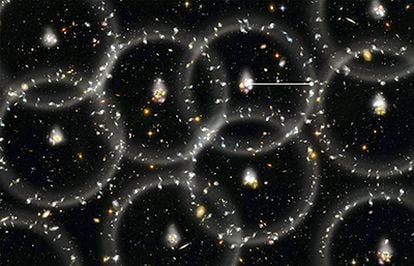Raindrops falling into a puddle, in Madrid.
Samuel Sanchez
Who has not been absorbed watching the first drops of rain fall on a puddle or a lake? It is hypnotic to see how they create concentric waves. Once many drops have fallen, the surface of the lake fills with ripples and that first circular symmetry fades and is lost forever. Or not ... Do you think it possible that by studying the tangle of ripples in the water at a certain moment we can know where the drops of water fell, or how many and what they were like? For something very similar is one of the most fascinating, not to say incredible and yet proven, predictions of the Big Bang theory.
Drops falling into the lake produce disturbances that move outward in wave form with a certain speed.
If we put a little boat we will see that it goes up and down, it does not move horizontally, which means that the wave only implies movements of the water molecules up and down.
It is what is called a transverse wave, which in this case travels out from the point of impact of the drop, forming concentric circles.
In a similar way to the drops falling into the lake, in the first moments of the universe, a fraction of a second after the Big Bang, what is known as "quantum fluctuations" were produced, random variations of the properties of the universe in certain areas
In a similar way to the drops falling into the lake, in the first moments of the universe, a fraction of a second after the Big Bang, it is not that something “fell” on it (technically, that is not possible), but they produced what known as "quantum fluctuations", random variations of the properties of the universe in certain areas. These fluctuations, possibly combined with what is known as inflation (another story), resulted in certain regions of the universe being denser than their surroundings. Like drops in a lake, these density peaks created a wave, though not a transverse wave like that of lake water, but a wave called acoustic, like sound in air.
These waves were mainly produced by the pressure exerted by the photons, which acted as a drum, giving rise to that "sound". That light exerts pressure on matter may seem incredible, but it can be seen, for example, in the structure of comets, which have tails pointing in the opposite direction to the Sun made up of particles pushed by photons from our star. In the early universe light and ordinary matter are said to be coupled. This means that the protons and neutrons, which are collectively called baryons, followed the behavior of the photons, thus forming part of that wave as well. The wave propagated from each overdensity at a fairly high speed, half that of light, corresponding to the speed of sound in the material that made up the universe at that time.In a similar way to the case of the lake, but in this case being an acoustic wave, concentric zones of greater density than the adjacent regions were formed and they were propagated away from the central overdensity. This is what is known as baryonic acoustic oscillations, BAO for its acronym in English.
Simplified representation of a BAO.Baryon Oscillation Spectroscopic Survey
However, in the center of each BAO remained, almost without realizing it, the overdensity dominated by dark matter, dark matter
black leg
, the one that astrophysicists include in all their theories, but that no one has found in the laboratory.
It is an exotic dark matter, which is not prone to capture or emit photons, it interacts with photons much less than normal (baryonic) matter.
As a consequence, the acoustic wave did not affect the dark matter, which "fought" for the mass-energy not to move away, what dark matter likes the most is the gravitational interaction.
The BAOs predicted by the theory are a phenomenon that has been observed, for the first time in 2005, by detecting a relatively high abundance of galaxies around the densest areas of the universe, just where the acoustic oscillations had reached the maximum before freeze in time
The spectacular events predicted by the Big Bang theory do not end there. One of the most important predictions of this theory is that at some point the universe went from being opaque to transparent, when its age was about 370,000 years. At that time electrons joined with protons or helium atoms (and a small number of other small atoms) and the matter of the universe went from being ionized to having a neutral charge. Without charged particles, the photons uncoupled from the baryons and traveled freely through the universe. Another consequence is that the baryon oscillations stopped, they did not continue to propagate. It is as if the ripples in the lake are suddenly frozen.
We summarize then that some of the main ingredients of the Big Bang theory, such as the existence of dark matter that does not interact with photons, the expansion and cooling of the universe, with processes such as the transition from an ionized universe to a neutral one, and the existence of matter overdensities from quantum fluctuations that gave rise to galaxies later, all of them explain something like BAOs.
The BAOs predicted by the theory are a phenomenon that has been observed, for the first time in 2005, by detecting a relatively high abundance of galaxies around the densest areas of the universe, just where the acoustic oscillations had reached the maximum before freeze in time. In these small overdensities and from the recombination, the action of gravity began to dominate, which gave rise to the formation of galaxies. The density was, of course, much larger at the center of each baryonic oscillation, where the dark matter had lain, so that center is where the largest galaxies formed, with a swarm of smaller galaxies emerging in the concentric layers created by BAOs. The result was spectacular and very difficult to obtain, because there was not a single oscillation,but rather a large number of them overlapping, tens of thousands were studied in that 2005 article.
The detailed study of baryonic acoustic oscillations at different times in the history of the universe is one of the fundamental projects of the Centro de Estudios Física del Cosmos de Aragón (CEFCA), which is finalizing the construction of a telescope at the Javalambre Astrophysical Observatory, in Teruel. In the coming years this project, among others, will give us a much more precise vision of how the universe has been expanding and will determine the properties of dark energy or the existence of something similar to quintessence. Watching the rain on a lake or the BAO will continue to fascinate and leave us absorbed, for sure.
Pablo G. Pérez González
is a researcher at the Astrobiology Center, dependent on the Higher Council for Scientific Research and the National Institute of Aerospace Technology (CAB / CSIC-INTA)
Cosmic Void
is a section in which our knowledge about the universe is presented in a qualitative and quantitative way. It is intended to explain the importance of understanding the cosmos not only from a scientific point of view but also from a philosophical, social and economic point of view. The name "cosmic vacuum" refers to the fact that the universe is and is, for the most part, empty, with less than 1 atom per cubic meter, despite the fact that in our environment, paradoxically, there are quintillion atoms per meter cubic, which invites us to reflect on our existence and the presence of life in the universe. The section is made up of
Pablo G. Pérez González
, researcher at the Center for Astrobiology;
Patricia Sánchez Blázquez
, Professor at the Complutense University of Madrid (UCM);
and
Eva Villaver
, researcher at the Center for Astrobiology
You can follow
MATERIA
on
,
and
, or sign up here to receive
our weekly newsletter








